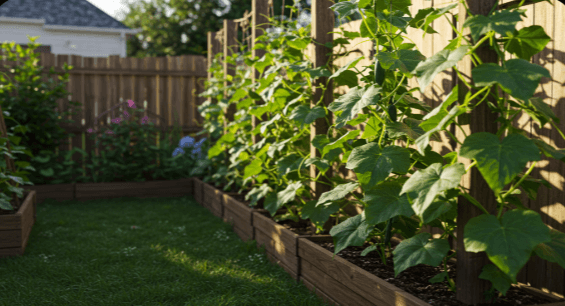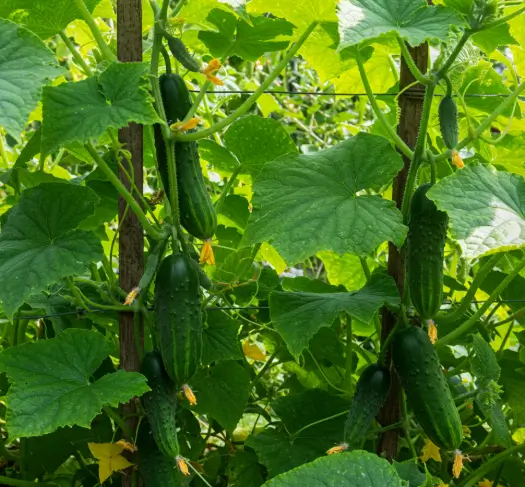Table of Contents
Why Grow Cucumbers Vertically?
Benefits of Vertical Gardening for Cucumbers
I still remember my neighbor, Doña Elena, a sprightly Mexican grandmother with a sun hat always askew and a laugh that filled the whole block. Her backyard garden was the size of a postage stamp, yet she managed to harvest enough produce to feed half the neighborhood. The secret? She grew up. Her cucumbers climbed up twine, over repurposed coat racks, and even around a bent chain-link fence. Inspired by her creativity, I began training my cucumbers vertically, which completely transformed my garden.
Growing cucumbers vertically offers numerous benefits:
- Space-saving efficiency: Perfect for small backyards, patios, or urban gardens where every inch counts.
- Healthier plants: Better air circulation reduces fungal diseases like powdery and downy mildew.
- Cleaner fruit: No more muddy cucumbers or rot from sitting on damp soil.
- Simplified harvesting: Easier to see and pick mature cucumbers, reducing accidental waste.
Vertical gardening, especially for vining crops like cucumbers, makes use of unused vertical airspace. It allows for closer planting at the base, leading to increased yields without additional land area. Additionally, it contributes to less bending and crouching, making gardening more accessible for elderly family members or those with mobility issues.
Bush vs. Vining Cucumber Varieties
When selecting cucumber varieties for vertical gardening, understanding the difference between bush and vining types is essential. I learned this the hard way when I tried to coax a stubborn bush cucumber up a trellis—an effort as frustrating as trying to walk a cat on a leash.
- Bush cucumbers are compact and ideal for containers. Their short vines make them easier to manage, but they often produce fewer fruits and require more ground space relative to their size. Examples include ‘Bush Pickle’ and ‘Bush Champion.’
- Vining cucumbers, on the other hand, are perfect candidates for vertical growth. These plants naturally reach upward, sending out tendrils to cling onto supports. Their growth habit makes them well-suited for trellises, netting, or any upright structure.
Key benefits of vining cucumbers:
- Naturally adapted to vertical systems
- Higher yields per plant
- Better fruit quality due to improved air exposure
From my experience, vining varieties are not only more productive but also more rewarding to grow. The way they stretch and spiral upward feels like nature’s choreography. If your goal is vertical productivity, vining types are the best partners.

Best Cucumber Varieties for Vertical Gardening
Top Vining Cucumber Varieties
My Aunt Marisol used to say, “A vine that climbs brings blessings.” She was talking about her backyard garden in Texas, where cucumber vines would snake up old chicken wire and shade her patio. From her, I learned that not all cucumbers are created equal, especially when it comes to vertical growth.
Here are a few top-performing vining cucumber varieties for vertical gardening that I have had personal success with:
- ‘Marketmore’: A beloved classic. This variety is incredibly disease-resistant and produces reliably even in hot weather. The dark green cucumbers grow up to 8 inches long and have a slightly bumpy skin. Marketmore thrives on a trellis and keeps producing through the season.
- ‘Straight Eight’: Named for its uniform, straight 8-inch fruits, this heirloom variety is a favorite among home gardeners. Its vigorous vines love to climb, making it an ideal candidate for vertical structures.
- ‘Lemon’: This unique variety produces small, round, yellow cucumbers that resemble lemons. Their refreshing flavor makes them a fun addition to salads and pickling jars. Plus, they look beautiful dangling from a trellis.
- ‘Armenian’: Technically a melon, this cucumber cousin produces long, slender fruits with a sweet, crisp texture. Because it can reach up to 36 inches in length, a strong trellis is a must. It thrives in heat and makes an elegant showpiece.
Each of these varieties offers a combination of productivity, disease resistance, and suitability for vertical systems. When I first planted Marketmore on a six-foot wooden trellis, I was amazed by how rapidly it covered the frame and produced flawless, uniform cucumbers every week.
Compact Varieties Suitable for Small Spaces
Not every gardener has room for towering trellises or sprawling vines. For those working with tight patios or balconies, compact cucumber varieties are a game-changer.
- ‘Bush Champion’: This short-vined variety is perfect for raised beds and containers. It produces full-sized cucumbers on compact plants and still responds well to a low trellis or tomato cage.
- ‘Spacemaster’: Aptly named, Spacemaster is ideal for container gardening and smaller vertical setups. It remains under 3 feet tall and still yields a generous harvest of crisp, tender fruits.
- ‘Patio Snacker’: Specifically bred for container and vertical growth, Patio Snacker is a personal favorite. With a tidy habit and great productivity, it’s ideal for first-time gardeners and seasoned growers alike.
These varieties prove that you do not need a large yard to grow delicious cucumbers. Even a modest balcony can support a vertical cucumber garden with the right cultivar.
Choosing the Right Trellis for Your Cucumbers
Types of Trellises for Vertical Gardening
As a child, I watched my grandmother grow cucumbers up an old wooden door propped against the shed. It was simple but effective. Today, there are many structured options for supporting vertical cucumber growth.
Here are the most popular trellis types:
- A-frame Trellises: These resemble a tent and offer stability, easy access, and maximum sunlight. They are great for both large gardens and small raised beds.
- Vertical Panels: Whether made of wire mesh or plastic netting, these flat panels save space and are ideal for lining garden borders or containers.
- Obelisks and Decorative Supports: These vertical towers double as garden art. While more aesthetic, they still offer strong support for climbing cucumbers.
When selecting a trellis, consider the height, strength, and durability. The structure should support the weight of growing cucumbers and withstand wind and weather.
DIY Trellis Ideas and Materials
For a more personal and budget-friendly approach, consider crafting your trellis using everyday materials:
- Bamboo poles: Lightweight, strong, and sustainable.
- PVC piping: Easy to cut and assemble into custom designs.
- Wooden stakes: Affordable and versatile.
You can also repurpose:
- Old ladders
- Tomato cages
- Closet racks
For vining varieties, anchor your trellis well and maintain a height of at least 5 to 6 feet. A stable base prevents tipping during heavy winds or when the vines become fruit-laden.
Planting and Caring for Cucumbers on a Trellis
Planting Techniques for Vertical Growth
I remember planting cucumbers for the first time with my mom in our small side yard. We built a simple wooden frame and sowed seeds at the base. Within weeks, tiny vines started climbing. The transformation was magical.
To start your vertical cucumber garden:
- Spacing: Plant seeds 12 inches apart for vining types, 18 inches for bush types.
- Soil: Use nutrient-rich, well-draining soil with compost or aged manure.
- Training the vines: As vines grow, gently guide them toward the trellis. You can use soft ties, twine, or garden clips to attach them.
- Supporting the fruit: For large cucumbers, use mesh or old pantyhose to create slings, preventing the fruits from weighing down or snapping the vines.
Maintenance Tips for Healthy Plants
Caring for cucumbers vertically involves regular attention:
- Watering: Maintain steady soil moisture, particularly while the plant is flowering and producing fruit.
- Fertilizing: Apply balanced fertilizer every two weeks during growth.
- Pruning: Remove lateral vines and old leaves to encourage airflow.
- Pest and disease control: Monitor for aphids, cucumber beetles, and mildew. Use neem oil or insecticidal soap as needed.
With proper care, a single plant can yield dozens of cucumbers. I have found that vertical cucumbers also stay cleaner, and pest damage is minimized.
For the soil, we have a detailed article click ( here )

Common Mistakes to Avoid in Vertical Cucumber Gardening
Overcrowding and Poor Air Circulation
One year, I got overzealous and planted eight cucumber seedlings on a single trellis. The result? A tangled mess with poor airflow, mildew issues, and low yields. Lesson learned.
Avoid planting too close together. Proper spacing ensures:
- Adequate sunlight
- Air circulation to prevent fungal diseases
- Easy access for harvesting and maintenance
Inadequate Support Structures
Using flimsy or weak supports can lead to disaster. Cucumbers are surprisingly heavy when mature. Trellises must be strong enough to handle the weight of both the vines and the fruit.
Tips:
- Use durable materials
- Anchor trellises securely in the ground
- Inspect for stability weekly
Vertical gardening is as much about structure as it is about soil and seeds.

FAQs:
What Kind of Cucumbers Grow Vertically?
Primarily, vining cucumbers grow vertically. These varieties naturally send out tendrils that cling to trellises or supports. Examples include:
- Marketmore
- Straight Eight
- Lemon Cucumber
Bush types can be coaxed up with help, but are less ideal for vertical growth.
What Should Not Be Planted Next to Cucumbers?
Avoid planting:
- Potatoes: Compete for nutrients
- Aromatic herbs: Can inhibit cucumber growth
- Melons: Share pests and disease risks
Good companions include:
- Beans
- Radishes
- Dill
Will Cucumbers Climb Straight Up?
Yes, with support. Vining cucumbers will climb straight up a trellis if guided. Use soft ties or clips during early growth.
Do You Need a Trellis for Marketmore Cucumbers?
While not necessary, Marketmore thrives with a trellis. Benefits include:
- Straighter fruits
- Less disease
- Easier harvesting

For more about cucumber planting, check this article ( Here)
Disclaimer: This article is for educational purposes only and does not replace professional gardening or agricultural advice. Consult local extension services for region-specific recommendations.
